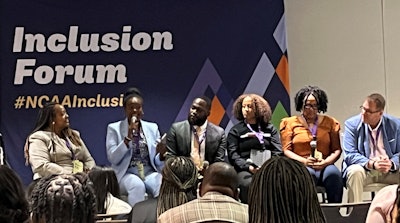INDIANAPOLIS — Despite the growing diversity at higher education institutions across the nation, too many student-athletes still find that they’re the “first” or the “only one” on their team or in their department. That topic was among many issues discussed Thursday at the NCAA Inclusion Forum.
The annual forum brought together more than 650 students, faculty, athletic directors, and administrators for a three-day conversation focused on enhancing diversity, equity, inclusion and belonging initiatives at colleges and universities. The forum also focused on the intersectional identities of student-athletes.
And when it comes to historically Black colleges and universities, many assume that diversity programming for student-athletes is either non-existent or not needed. The annual NCAA Inclusion Forum convened more than 650 students, faculty, athletic directors, and administrators.
The annual NCAA Inclusion Forum convened more than 650 students, faculty, athletic directors, and administrators.
That’s not true, said panelists who added that the definition of diversity has to be broadened and expanded beyond the contours of race.
“All Black students are not the same,” said Frank D. Dorsey, II, dean of student involvement and leadership at University of Arkansas, Pine Bluff, adding that focusing on the places where students come from can help to facilitate a culture of belonging on campus.
Christina Ruffin, assistant athletic director for academics and student services at Norfolk State University, agreed, saying that the misconceptions about HBCUs is that the students are the same.
“We have first-generation students and students from different social economic backgrounds,” said Ruffin. “One of the biggest misconceptions is that the degree at an HBCU will not weigh the same, and that is not true. We have great programs at HBCUs, but our stories are not told as much.”
Socioeconomic differences, said Dorsey, are often overlooked in conversations about diversity at HBCUs. But more institutions are being intentional about creating safe spaces to discuss about class. Still, the vibrant culture and inclusivity at HBCUs historically have been a place where students say that they feel like they can be themselves.
“Our students have different needs, and you can’t treat them all the same,” said Dorsey.
Travis Jarome, associate athletic director for public relations and sports media at Jackson State University, said that student-athletes at HBCUs have to be integrated into the local community as mentors and models to younger students. Jarome said the goal of institutions is to do a better job of helping to reshape and redefine the narrative, particularly as it relates to student-athletes.
Given that so many HBCUs have been historically underfunded, Dr. Kristine Kelly, director of athletics at Albany State University, said that it's important for non-HBCU institutions to give HBCU graduates a serious look.
“Hire our HBCU graduates, if you have the opportunity,” said Kelly.






















